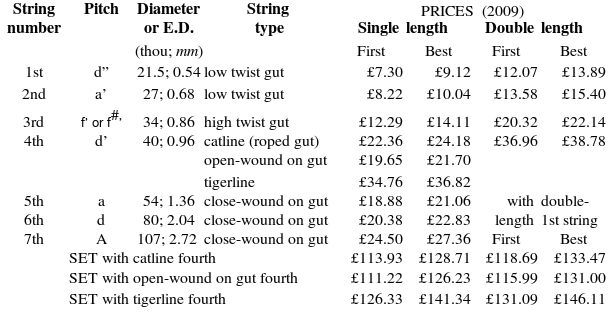
Northern Renaissance Instruments
6 Needham Avenue, Chorlton-cum-Hardy, Manchester M21 8AA, U.K.
Phone & Fax. +44 (0) 161 881 8134 ; propretor: Dr. Ephraim Segerman [USA]
e-mail: post@nrinst.co.uk ; on internet: http://www.nrinst.co.uk
VIOLA D’AMORE STRINGS
BOWED STRINGS
This leaflet is about strings for an instrument with six or seven gut bowed strings plus the same number of metal sympathetic strings located under the bowed strings. The string stop (nut-to-bridge distance) for both sets of strings is about 36 cm. The bowed strings are tuned to A, d, a, d’, f’ or f#’, a’ and d” (if there are six strings, the A is omitted). It was most popular in the 18th century, but has occasionally been called for in orchestras since then. There have been instruments with other specifications called ‘viola d’amore’, but information on their stringing needs to be applied for separately.
These instruments, whilst having bodies of viol construction, are usually played by musicians trained as violinists. They find its resonances rather tame and uniform, and fine optimisation of the stringing has rarely been found necessary. Therefore we offer one standard set which will satisfy the vast majority of players. It is fine for both a’=415 and 440 Hz.
There is a choice of 4th string type. Open-wound metal on gut is most authentic for the 18th century and provides the smoothest transition in sound between the unwound and the close-wound strings. But the bumpy surface inhibits sliding of the finger or the bow while the string is sounding, and many players find this unacceptable. Most of these players find a polished catline is an adequate substitute, but many prefer a tigerline (which is an historical possibility), that sounds more like an open-wound string without the above disadvantage.
The First Quality strings include those wound with silver-plated copper (unplated copper at the same price is an option that can be requested). ‘Best’ unwound strings are chemically treated to be more stable in tuning and resistant to chemical attack and scuffing, and tend to last longer. ‘Best’ wound strings are wound with solid silver wire.

SYMPATHETIC STRINGS
The purpose of a sympathetic string is to soak up vibration energy at its tuned pitch (and/or the harmonics of that pitch) from the bowed strings via the bridge, and then to keep humming on after the contributing bowed notes stop. This is a kind of artificial reverberation similar to that which sound engineers add to recordings to make instruments or voices sound warmer.
The pitches, diameters and materials of the sympathetic strings are somewhat arbitrary. When they were first introduced, it was for the lyra viol early in the 17th century. A steel that could tune as high as gut was then available, as well as twisted brass strings for particularly low notes. The tuning was in unison or octaves with the bowed strings. After about 1620 that steel became unavailable, and not until piano wire was invented late in the 19th century was there again a string material that was this strong. In the 18th century, twisted brass strings were not commonly available. Consequently, unison tuning is anachronistic through the period of most use of the viola d’amore. We include this option because customers keep asking for it.
The authentic options (according to the information given by Leopold Mozart (1756) and in l’Encyclopédie (1767-72) edited by Diderot) are tuning either in a diatonic scale or in the chord of the bowed strings, using plain metal strings of either iron or brass (not both). The latter involves several sympathetic strings tuned to each note (the 18th century trumpet marine had dozens). Diatonic tuning is for when the music modulates a lot into different keys, and chord tuning is for music that mostly stays in the key of D major or minor. Iron strings last longer and stabilise more quickly after they are put on, while brass strings have a richer tone. Since the sympathetic strings don’t need to have uniform tension as the bowed strings do, two string diameters (around 12 thou for the higher pitches and 16 thou for the lower) will serve for all of the strings and both tunings using either metal.
To avoid string breakage on the highest strings and to retain decent tone on the lowest, we recommend that iron strings be tuned in the range a to g’ and brass strings in the range f or f# to e'. The following table gives the suggested pitches as well as approximate diameters of the sympathetic strings that keeps tensions between 2 and 5 Kg.

Sympathetic
strings are sold either individually, provided with loops, or as
5-metre coils of wire for each diameter, in which case the musician
makes his or her own loops (instructions provided). Metal string
prices are the same for all diameters of each type.
